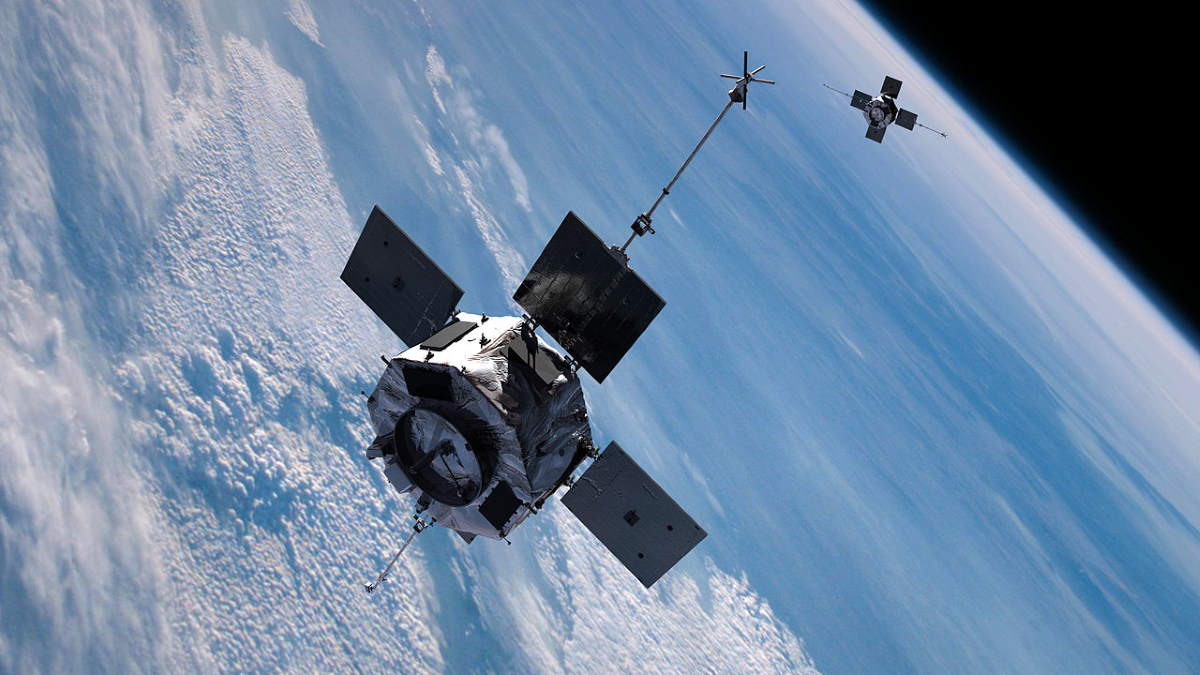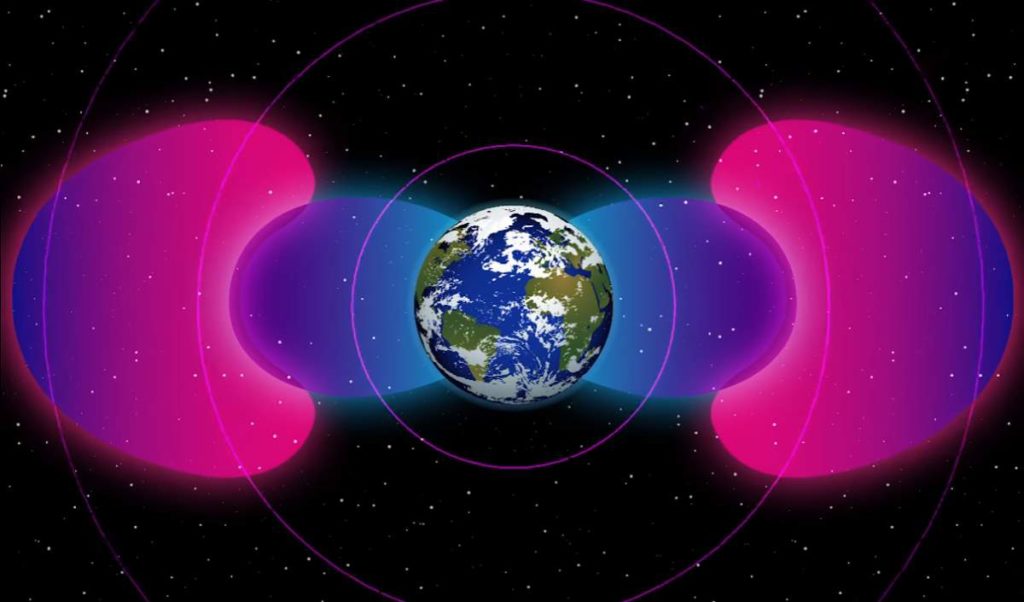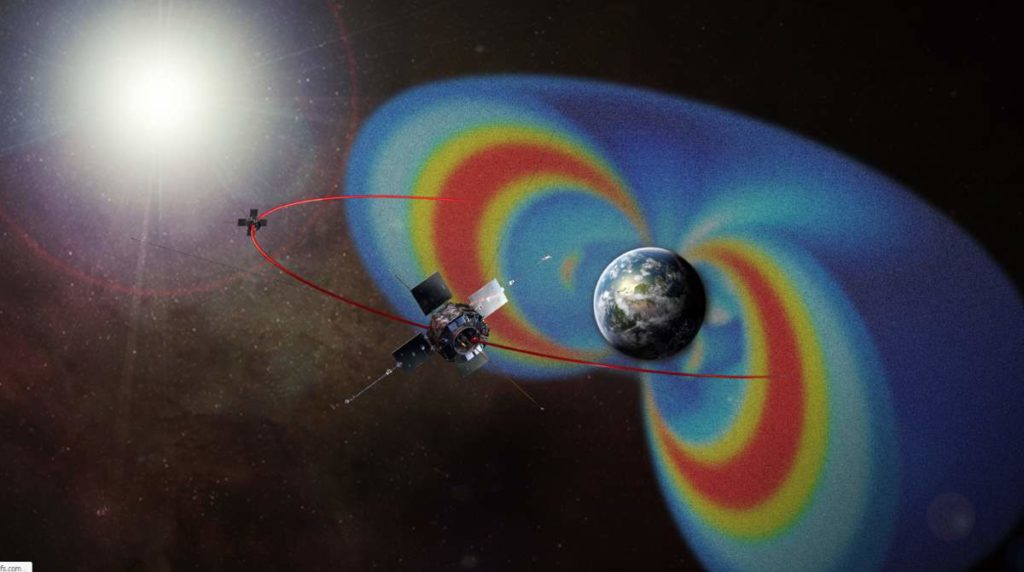On October 18, 2019, NASA held an AMA (Ask Me Anything) on Reddit. Scientists from the space agency answered questions about Van Allen Probes, two robotic spacecraft that were used to study the Van Allen radiation belts that surround planet Earth.
NASA has announced that:
“We’re saying goodbye to the Van Allen Probes. The two Van Allen Probes studied the clouds of particle radiation trapped in Earth’s magnetic field, and we’re sending the final command to shut down the second spacecraft on October 18.”
“Even though they were designed for a two-year mission, the spacecraft lasted for about seven years in one of the harshest environments in space.”
“We’re ending the mission because we used our remaining fuel to place the spacecraft in a lower orbit that will eventually decay, letting the spacecraft re-enter and burn up in Earth’s atmosphere.”

Originally slated for a two-year mission, the spacecraft flew through the Van Allen belts – rings of charged particles trapped by Earth’s magnetic field – to understand how particles were gained and lost by the belts. The spacecraft made major discoveries that revolutionized how we understand our near-Earth environment.
With instruments measuring electromagnetic fields and charged particles, the Van Allen Probes explored the invisible phenomena of shepherding particles in and around the belts. It made discoveries about the architecture of the belts and the forces shaping them. Just as ocean storms on Earth can create giant waves, space weather, caused by the Sun, can create plasma waves, where seas of particles are tossed by electromagnetic fields. The Van Allen Probes pioneered new explorations into the dynamics of these waves and their effects on our near-Earth environment.
Some Questions & Answers from NASA’s AMA about Van Allen Probes
NASA scientists answering the questions about Van Allen Probes were:
- Nelli Mosavi, Van Allen Probes project manager, Johns Hopkins Applied Physics Lab
- David Sibeck, Van Allen Probes mission scientist, NASA Goddard
- Madeline Fosbury, Van Allen Probes mission system engineer, Johns Hopkins Applied Physics Lab
- Tom Sotirelis, Van Allen Probes deputy project scientist, Johns Hopkins Applied Physics Lab
Question:
How exactly do you protect manned spacecraft and unmanned probes and such full of delicate electronics from the radiation beyond the Van Allen belt when they journey there?
Answer:
The protection needed depends on the environment the spacecraft is traveling through. Generally,
- [planners] shield [the spacecraft] with an appropriate thickness of metal
- Use radiation-hardened parts
- and design the system to safely dissipate the accumulated charge.
Planners also try to plan the trajectory to minimize the time in the most hazardous environments.
(Answered by Tom Sotirelis)
Question:
The ships were designed for a two-year mission, yet lasted seven. What were the factors that led to the extended lifespan of these spacecraft and can we use that knowledge when assessing the longevity of future spacecraft?
Answer:
That’s an interesting question! The design was very robust and well thought through. We had a reasonable safety margin, and while the mission was only for two years initially, many spacecraft are designed with the extended mission in mind.
(Answered by Nelli Mosavi)
Question:
Has any of the data obtained by this spacecraft been used or will be used to develop electrodynamic tether propulsion/technology?
Answer:
No such technology is being currently developed using Van Allen Probes data.
(Answered by Tom Sotirelis)
Question:
What, apart from the third Van Allen belt discovery, has been the most surprising result of interpreting the data received?
Answer 1:
One of the biggest discoveries was that radiation belt electrons are accelerated in situ – right where they are found – by intense plasma wave activity. Prior to the mission, many researchers thought that they were energized as they were transported inward from distances further from Earth. Having two Van Allen Probes spacecraft was the key to answering this question.
With two spacecraft, researchers could see radiation intensities rising in the heart of the belts while little to nothing was happening further from Earth. This and the presence of plasma waves in the radiation belts were the clues that indicated that electrons gain their energy right in the belts.
(Answered by David Sibeck)
Answer 2:
The Van Allen belts are composed of electrons and ions with a range of energies. My favorite discovery was that, in 2015, research from the Van Allen Probes found that, unlike the outer belt, there were no electrons with energies greater than a million electron volts in the inner belt. For our selected discoveries, please visit here.
(Answered by Nelli Mosavi)
Question:
Can you give us a counterpoint to moon landing deniers saying that “landing on the moon was impossible because the astronauts would have died passing through the Van Allen belt”?
Answer 1:
With the amount of shielding and speed that went through the radiation belt, the astronauts were safe.
(Answered by Nelli Mosavi)
Answer 2:
The charged particles (ions and electrons) in the radiation belts can disrupt sensitive circuits on spacecraft and cause immediate failures. Harming astronauts would require prolonged exposure and increase the likelihood of cancer. As the answer above indicates, the solution is to keep astronauts inside and shielded by their spacecraft walls while passing through the belts.
(Answered by David Sibeck)
Question:
Is magnetic reconnection better understood now thanks to the data from these probes?
Answer:
Understanding the microphysics of reconnection is a task for NASA’s Magnetospheric Multiscale (MMS) mission. The apogees of the MMS spacecraft extend far beyond that of the Van Allen Probes spacecraft, enabling the four identical MMS spacecraft to observe reconnection at the dayside magnetopause and in the Earth’s magnetotail. The Van Allen Probes spacecraft have apogees in the radiation belts and do not reach these locations. Here is a good website to learn more about the MMS mission: mms.gsfc.nasa.gov
(Answered by David Sibeck)
Question:
Is there going to be a successor to the Van Allen Probes? Also how emotionally attached do you get to the probes? It would be heartbroken sending the final shutdown command.
Answer 1:
We all get emotionally attached to the mission, but in the end, we are happy that this mission accomplished its goals and provided more data science than we could ever have imagined. We’re always hopeful there will be more missions like this in the future.
(Answered by Nelli Mosavi)
Answer 2:
There is no immediate plan to launch a mission to replace the Van Allen Probes, but rest assured that there are plenty of scientists and engineers working in that direction. We could use observations from such missions to feed into advanced models predicting space weather conditions in Earth’s vicinity. And to make more discoveries about fundamental physics.
(Answered by David Sibeck)
Question:
What was the purpose of using two probes instead of just one?
Answer:
Two spacecraft help us distinguish between spatial and temporal effects. We used the spacecraft to determine whether particles or waves were moving from one location to another, or occurring simultaneously in two different places. We used them to determine where the radiation belt particles are energized, transported, and lost by figuring out where and when they first increase, how they move, and where they first decrease. It is kind of like having a start and stopwatch on a racecourse. You can see where things begin, and where they end.
(Answered by David Sibeck)
Question:
Knowing what you know now, If you could design a second mission to the Van Allen belts, what would you be interested in investigating further?
Answer:
We’ve made some really exciting discoveries, but there is so much more to do. Some of the things we would like to do if designing a second mission would be to have multiple spacecraft on multiple orbits to cover the radiation belts and know exactly what is happening at each and every location. Right now we have to make assumptions above what is happening at locations where there are no spacecraft.
(Answered by David Sibeck)
Question:
What kind of orbit (height and general shape) are the crafts currently in, and how are you modifying those orbits to deorbit the crafts? Also, how long will they take to deorbit?
Answer:
These spacecraft are in a highly elliptical orbit, about 19,000 miles away from the Earth at the furthest point and 370 miles at the closest point. In February and March, we lowered the perigee altitudes (the closest point) to about 160 miles. This is low enough that the spacecraft would begin going through Earth’s atmosphere.
The spacecraft will de-orbit in about 15 years.
(Answered by Madeline Fosbury)
Question:
Is the most important issues you’re hoping to tackle how to better protect our Astronauts from the extremely deadly radiation exposure they’d have to endure during extended deep space travel?
Answer:
When you’re traveling to Mars, that’s different radiation. The radiation exposure there is occasional solar energetic particle events. When energetic particles are ejected by the Sun they can cause hazardous radiation exposure. That is why there is a consideration for long-term effects for astronauts going to Mars.
(Answered by Tom Sotirelis)
Ten Highlights From NASA’s Van Allen Probes Mission
From NASA.gov:
- The Van Allen belts were first discovered in 1958 and for decades scientists thought there were only two concentric belts. But days after the Van Allen Probes launched, scientists discovered that during times of intense solar activity, a third belt can form.
- The belts, which are composed of charged particles and electromagnetic fields, can be energized by different types of plasma waves. One type, called electrostatic double layers, appears as short blips of an enhanced electric field. During one observing period, Probe B saw 7,000 such blips repeatedly pass over the spacecraft in a single minute. These individually small events added up to one million volts over six minutes, capable of accelerating electrons up toward the relativistic energies are commonly seen in radiation belt particles.
- During big space weather storms, which are ultimately caused by activity on the Sun, ions – electrically charged atoms or molecules – can be pushed deep into Earth’s magnetosphere in a series of impulsive events. These particles carry electromagnetic currents that circle around the planet and can dramatically distort Earth’s magnetic field.
- Across space, fluctuating electric and magnetic fields can create what are known as plasma waves. These waves intensify during space weather storms and can accelerate particles to relativistic speeds. The Van Allen Probes found that one type of plasma wave known as hiss can contribute greatly to the loss of electrons from the belts.
- The Van Allen belts are composed of electrons and ions with a range of energies. In 2015, research from the Van Allen Probes found that, unlike the outer belt, there were no electrons with energies greater than a million electron volts in the inner belt.
- Plasma waves known as whistler chorus waves are also common in our near-Earth environment. These waves can travel parallel or at an angle to the local magnetic field. The Van Allen Probes demonstrated the two types of waves cannot be present simultaneously, resulting in greater radiation belt particle scattering in certain areas.
- Very low-frequency chorus waves, another variety of plasma waves, can pump up the energy of electrons to millions of electron volts. During storm conditions, the Van Allen Probes found these waves can hugely increase the energy of particles in the belts in just a few hours.
- Scientists often use computer simulation models to understand the physics behind certain phenomena. A model simulating particles in the Van Allen belts helped scientists understand how particles can be lost, replenished and trapped by the Earth’s magnetic field.
- The Van Allen Probes observed several cases of extremely energetic ions speeding toward Earth. The research found that these ions’ acceleration was connected to their electric charge and not to their mass.
- The Sun emits faster and slower gusts of charged particles called the solar wind. Since the Sun rotates, these gusts — the fast wind – reach Earth periodically. Changes in these gusts cause the extent of the region of cold ionized gas around Earth – the plasmasphere – to shrink. Data from the Van Allen Probes showed that such changes in the plasmasphere fluctuated at the same rate as the solar rotation – every 27 days.
One of the most common forms of space weather, a geomagnetic storm describes any event in which Earth’s magnetic environment – called the magnetosphere – is suddenly, temporarily disturbed. Such an event can also lead to change in the radiation belts surrounding Earth, but researchers have seldom been able to observe what happens within the first few minutes immediately following a shock.
On the day of the March 2015 geomagnetic storm, one of the Van Allen Probes was located at just the right spot within the radiation belts, providing unprecedentedly high-resolution data from a rarely witnessed phenomenon.
Sources
- Ten Highlights From NASA’s Van Allen Probes Mission on NASA.gov
- NASA’S AMA (Ask Me Anything) on Reddit
- Van Allen Radiation Belts on Wikipedia
- Van Allen Probes on Wikipedia
- Budget of NASA, Year by Year [1980-1989] - June 10, 2024
- Budget of NASA, Year by Year [1970-1979] - June 10, 2024
- Budget of NASA, Year by Year [1958-2024] - June 10, 2024

